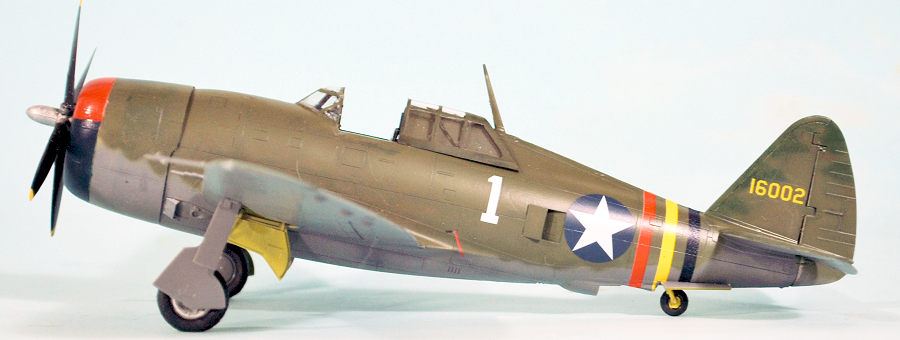
Dora Wings 1/48 P-47B Thunderbolt
| KIT #: | DW 48051 |
| PRICE: | $55.00 |
| DECALS: | Four options |
| REVIEWER: | Tom Cleaver |
| NOTES: | Short run with p.e. and masks |

| HISTORY |
Originally designed to meet an Air Corps specification for a high-altitude point-defense interceptor, forced to become a long-range escort fighter for lack of an alternative, then finding its metier as a low-altitude ground attack aircraft, the amenability of the P-47 Thunderbolt to take on roles unforeseen when the XP-47B rolled out of Republic aircraft’s Farmingdale factory in early 1941 guaranteed its place in history as one of the truly outstanding aircraft of the World War II.
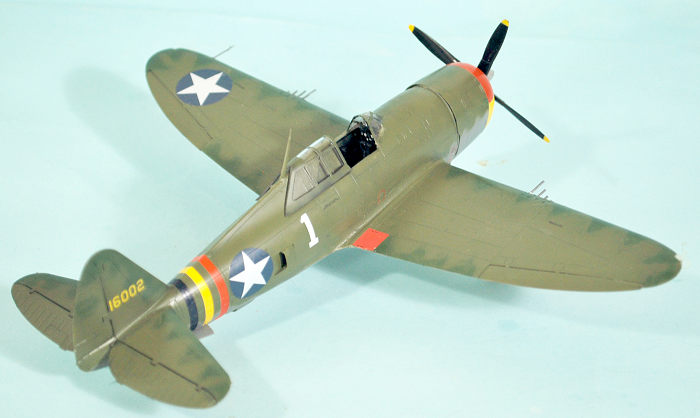 The P-47
was the final result of the work of one of the most visionary figures in
aviation, Alexander P. deSeversky. Seversky’s most important contribution to
aviation development was hiring fellow Georgian Alexander Kartveli. Born
Alexander Kartvelishvili in Tblisi, Georgia, on September 9, 1896, he moved
to Paris in 1914 to study aeronautical engineering and graduated in 1922
from the Highest School of Aviation in Paris. Between 1922–1927, he worked
as a designer at the Louis Blériot company. In 1924, one of his designs
established a world speed record. American millionaire Charles Levine
invited him to come to New York, to join the Atlantic Aircraft Corporation
in 1928, where he didn’t like working on Fokker designs. Kartvelishvili met
Alexander deSeversky in 1931 and went to work for his fellow Georgian,
“Americanizing” his name to Kartveli.
The P-47
was the final result of the work of one of the most visionary figures in
aviation, Alexander P. deSeversky. Seversky’s most important contribution to
aviation development was hiring fellow Georgian Alexander Kartveli. Born
Alexander Kartvelishvili in Tblisi, Georgia, on September 9, 1896, he moved
to Paris in 1914 to study aeronautical engineering and graduated in 1922
from the Highest School of Aviation in Paris. Between 1922–1927, he worked
as a designer at the Louis Blériot company. In 1924, one of his designs
established a world speed record. American millionaire Charles Levine
invited him to come to New York, to join the Atlantic Aircraft Corporation
in 1928, where he didn’t like working on Fokker designs. Kartvelishvili met
Alexander deSeversky in 1931 and went to work for his fellow Georgian,
“Americanizing” his name to Kartveli.
In late 1939, Kartveli commenced work on the AP-10, a lightweight fighter powered by the Allison V-1710 liquid-cooled V-12 engine; the eight .50-calbre M2 Browning machine guns were an astounding armament considering that the Spitfire and Hurricane each carried eight ,30-calibre weapons. The Air Corps backed the project, designating it XP-47.
By the spring of 1940, Kartveli and the Air Corps concluded that both the XP-44, the XP-47 and the XP-47A offered as a ‘fix’ were inferior to Luftwaffe fighters. Kartveli then designed a much larger fighter, offered to the USAAC in June 1940. Kartveli had learned his lesson from the USAAC rejection of the ‘wet wing’ and the new design was specifically a point-defense interceptor. The Air Corps and ordered a prototype in September, designated XP-47B, though it had nothing in common with either the XP-47 or the XP-47A.
The XP-47B was all-metal construction with fabric-covered elevators and rudder, with a semi-elliptical wing that went back to the P-35. The air-conditioned cockpit was roomy - so much so that when the airplane arrived in England, Spitfire pilots joked that when attacked, the pilot could unstrap and take evasive action dodging about the cockpit. Main and auxiliary self-sealing fuel tanks under the cockpit provided 305 U.S. gal, deemed more than sufficient for the intended interceptor role.
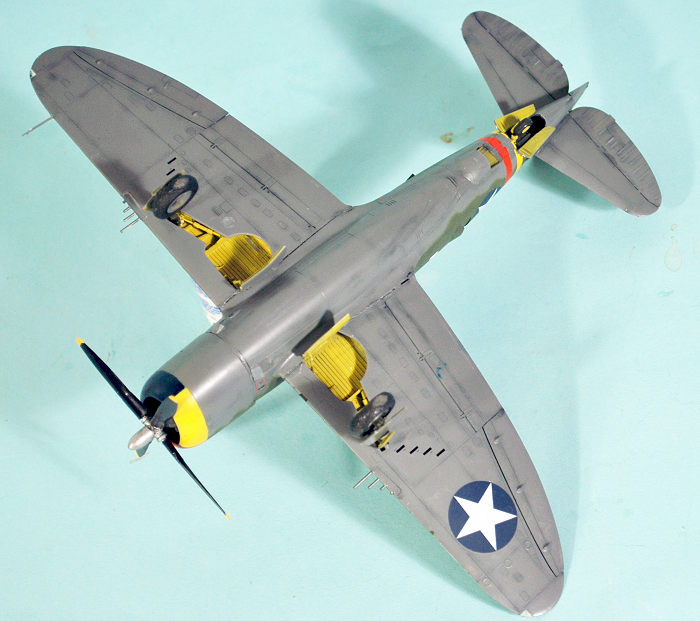 The
powerplant was the new Pratt & Whitney R-2800 Double Wasp two-row
18-cylinder radial engine producing 2,000hp, using a four-bladed Curtiss
Electric constant-speed propeller 12 feet 2 inches in diameter. The engine
cowling ducted cooling air for the engine, left and right oil coolers, and
the turbo supercharger intercooler system with exhaust gases routed into a
pair of wastegate-equipped pipes running to either side of the cockpit
providing power for the turbosupercharger located in the lower rear
fuselage. At full power, the pipes glowed red at their forward ends,
spinning the turbine at 21300rpm. The complicated ductwork and turbo
supercharger gave the XP-47B a deep fuselage; thus, the wings were mounted
relatively high, which in turn required long-legged main landing gear struts
to provide ground clearance for the enormous propeller. In order to assure
sufficient room in the wings for the guns and ammo, the gear legs telescoped
the strut 9 inches when extended. The armament of eight Browning AN/M2
.50-calibre machine guns were mounted outboard of the landing gear, with
their 500rpg ammunition bays filling the outer wing.
The
powerplant was the new Pratt & Whitney R-2800 Double Wasp two-row
18-cylinder radial engine producing 2,000hp, using a four-bladed Curtiss
Electric constant-speed propeller 12 feet 2 inches in diameter. The engine
cowling ducted cooling air for the engine, left and right oil coolers, and
the turbo supercharger intercooler system with exhaust gases routed into a
pair of wastegate-equipped pipes running to either side of the cockpit
providing power for the turbosupercharger located in the lower rear
fuselage. At full power, the pipes glowed red at their forward ends,
spinning the turbine at 21300rpm. The complicated ductwork and turbo
supercharger gave the XP-47B a deep fuselage; thus, the wings were mounted
relatively high, which in turn required long-legged main landing gear struts
to provide ground clearance for the enormous propeller. In order to assure
sufficient room in the wings for the guns and ammo, the gear legs telescoped
the strut 9 inches when extended. The armament of eight Browning AN/M2
.50-calibre machine guns were mounted outboard of the landing gear, with
their 500rpg ammunition bays filling the outer wing.
All of this meant the XP-47B was very heavy when compared to contemporaries. The empty weight of 9900lb was 65% more than the P-43; it would be the heaviest single-seat fighter used during the war. Kartveli said, "It will be a dinosaur, but it will be a dinosaur with good proportions.”
Republic test pilot Lowry P. Brabham first flew the XP-47B on May 6, 1941. By then it had been given the emotive name “Thunderbolt” and was impressive in early trials. The prototype was lost in an accident on August 8, 1942; by then it had achieved a level speed of 412mph at 25800ft and climbed from sea level to 15000ft in five minutes. While the XP-47B gave the newly renamed United States Army Air Forces cause for optimism, it had its share of teething problems that caused an equal amount of apprehension.
The Thunderbolt’s sheer size and limited ground-propeller clearance after lifting off the tail wheel into a fuselage-level attitude made for challenging takeoffs requiring long runways and meant the pilot had to hold the tail low until close to takeoff speed on the initial run. The sideways-opening canopy had a tendency to jam. The gun installation’s tight fit and cramped ammunition belt tracks led to jamming, especially during and after hard manoeuvering. The ailerons "snatched and froze" at high altitude while control loads were deemed excessive at higher speeds. Power was affected by ignition wiring arcing. Republic soon fitted a rearwards-sliding canopy, a pressurized ignition system and eventually all-metal control surfaces appeared in the combat-capable P-47C.
The USAAF ordered 171 P-47Bs shortly after the prototype’s first flight, with the first production P-47B delivered in December 1941.
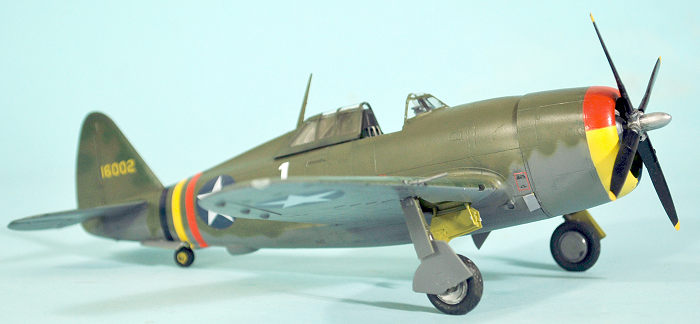 Teething
problems continued. A Republic test pilot was killed in the fifth production
P-47B when it went out of control in a dive on March 26, 1942, crashing due
to tail assembly failure after fabric-covered tail surfaces ballooned and
ruptured. This was the first indication the Thunderbolt’s performance
brought pilots into the transonic flight regime where they experienced the
never-encountered phenomenon of “compressibility” as speed approached Mach
1.
Teething
problems continued. A Republic test pilot was killed in the fifth production
P-47B when it went out of control in a dive on March 26, 1942, crashing due
to tail assembly failure after fabric-covered tail surfaces ballooned and
ruptured. This was the first indication the Thunderbolt’s performance
brought pilots into the transonic flight regime where they experienced the
never-encountered phenomenon of “compressibility” as speed approached Mach
1.
The newly-formed 56th Fighter Group had moved to Mitchell Field, Long Island, not far from the Republic factory, in April 1942, and was the initial unit to equip with the P-47B, with the first arriving in June 1942. Their proximity to the factory made the 56th the operational evaluation unit for the new fighter over the next six months. As they gained experience over the course of the summer, Republic made numerous modifications as a result of unsatisfactory reports from 56th pilots and engineers.
In September 1942, the 56th group welcomed a new commander, Major Hubert Zemke. Born in Montana in 1914, Zemke had never exhibited any interest in airplanes or flying as a youth. Promoted to Captain, Zemke was sent to England in September 1940 as a combat observer with the Royal Air Force, where he studied the tactics of both the RAF and the Luftwaffe. The next year, he was sent to the Soviet Union to instruct Russian pilots on flying Lend-Lease P-40s. After his return to the United States in February 1942, he was one of the first Air Corps pilots to fly the XP-47B that spring. His experience with the P-47 and knowledge of European air combat made him a natural choice to take over the 56th.
| THE KIT |
 Dora Wings has
so far produced the major aircraft in the history of the P-47 - the P-35 and
P-43. This kit of the P-47B is the first time a kit of this Thunderbolt sub-type
has been produced as a plastic kit. As with all other Dora Wings kits, this is a
“high end/limited-run” kit. If you treat it as a “limited-run kit” while
assembling it, it will look like a “high end model” when completed.
Dora Wings has
so far produced the major aircraft in the history of the P-47 - the P-35 and
P-43. This kit of the P-47B is the first time a kit of this Thunderbolt sub-type
has been produced as a plastic kit. As with all other Dora Wings kits, this is a
“high end/limited-run” kit. If you treat it as a “limited-run kit” while
assembling it, it will look like a “high end model” when completed.
The gray plastic has a smooth, shiny surface. There is little flash on the parts. Unlike previous Dora Wings kits, the cooling flaps on the engine cowling are not produced as separate photo-etch.
Four P-47Bs are offered in the decal sheet: the P-47B flown by Hub Zemke; an early P-47B in the 56th group; the seventh P-47B produced, which has special markings; a TP-47B sent to Brazil in 1944 as a trainer.
| CONSTRUCTION |
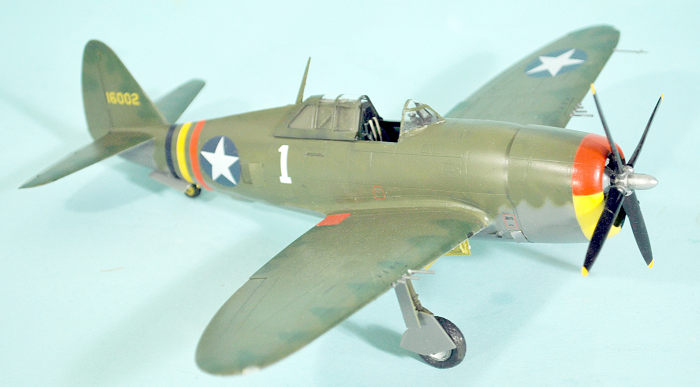 Overall, this
kit was easier to assemble than the P-35 and P-43 kits. It you take care in
assembly, and study the instructions to be sure you understand what is to be
done in each step, you will not need filler other than to run some CA glue along
the fuselage centerline seam..
Overall, this
kit was easier to assemble than the P-35 and P-43 kits. It you take care in
assembly, and study the instructions to be sure you understand what is to be
done in each step, you will not need filler other than to run some CA glue along
the fuselage centerline seam..
The main difficulty was in attaching the wings to the fuselage. I found with that, that if I pre-fit the wing to the fuselage, then flooded the attachment area with Tamiya Extra-Thin liquid glue, and then pressed the wing to the fuselage section by section, I was able to get good fit and did not have to use any filler in the joint.
I suggest that with the wing guns, you trim the attachment point that goes in the wing flat, then glue the gun barrels into the cover part that fits into the leading edge of the wing, and then put that aside and attach the guns after you have assembled the rest of the model, you will not break off the gun barrels.
The canopy comes in the closed position, which is to allow the early version with extra windows to be done. Zemke’s P-47B was a late production airplane with the “standard” rasorback sliding canopy. I was thus able to cut the canopy from the rear section and attach the rear section to the fuselage, allowing me to pose the canopy open.
| COLORS & MARKINGS |
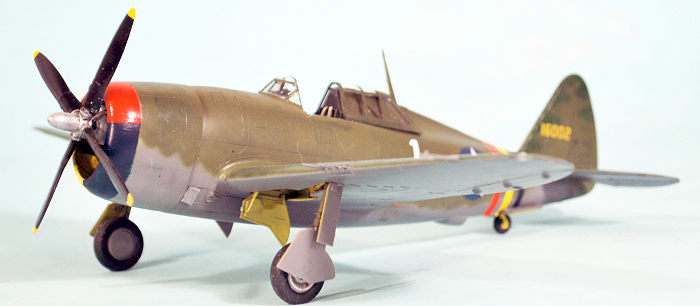 The P-47B was
painted in “green base” OD-41 Olive Drab. I used Tamiya “Olive Drab 2" acrylic
lacquer, which is close enough to this shade. I used Gunze-Sangyo acrylic
lacquer Neutral Grey for the lower surface. According to the better-researched
Three Guys Replicas decal sheet for Zemke’s airplanes which I have had in the
stash for 25 years, the airplane had the medium green “blobs” on the wings,
horizontal stabilizer and vertical fin. I used the drawing in the Three Guys
marking diagram to do this, using Tamiya “Deep Green” acrylic”
The P-47B was
painted in “green base” OD-41 Olive Drab. I used Tamiya “Olive Drab 2" acrylic
lacquer, which is close enough to this shade. I used Gunze-Sangyo acrylic
lacquer Neutral Grey for the lower surface. According to the better-researched
Three Guys Replicas decal sheet for Zemke’s airplanes which I have had in the
stash for 25 years, the airplane had the medium green “blobs” on the wings,
horizontal stabilizer and vertical fin. I used the drawing in the Three Guys
marking diagram to do this, using Tamiya “Deep Green” acrylic”
I also followed the Three Guys painting instructions for the tri-color cowling ring on Zemke’s airplane, which is more accurate than the painting instruction in the Dora Wings kit.
I used the personal markings for Zemke’s airplane, and the kit decals for the national markings and stencils. Everything went down without problem under some Solvaset.
I used the tailwheel assembly from an old Monogram P-47 kit for the tailwheel, because it was more sturdy than that provided in the kit - the kit is “scale thickness” but looks very fragile. I also used the main wheels from the Monogram kit because they had tread. I attached the canopy in the open position and called things done.
| CONCLUSIONS |
This kit does not assemble like a Tamiya P-47, but with care, the final result can sit next to a Tamiya kit and look like it belongs there. The P-47 is one of my favorite World War II fighters, and having the first sub-type in the collection is a nice addition. I recommend this kit to modelers with experience in “high-end/limited-run” kits. Recommended for all P-47 fans.
19 October 2023
Review kit courtesy of Dora Wings.
Copyright ModelingMadness.com. All rights reserved. No reproduction in part or in whole without express permission of the editor.
If you would like your product reviewed fairly and fairly quickly, please contact the editor or see other details in the Note to Contributors.
Back to the Main Page Back to the Review Index Page Back to the Previews Index Page